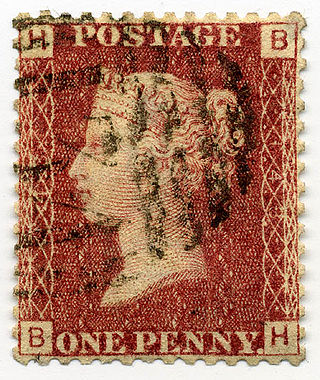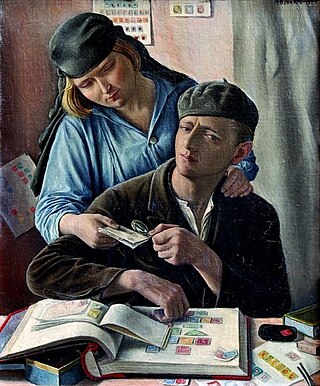
Philately is the study of postage stamps and postal history. It also refers to the collection and appreciation of stamps and other philatelic products. Philately involves more than just stamp collecting or the study of postage; it is possible to be a philatelist without owning any stamps. For instance, the stamps being studied may be very rare or reside only in museums.

Stamp collecting is the collecting of postage stamps and related objects. It is an area of philately, which is the study of stamps. It has been one of the world's most popular hobbies since the late nineteenth century with the rapid growth of the postal service, as a never-ending stream of new stamps was produced by countries that sought to advertise their distinctiveness through their stamps.

The Inverted Jenny is a 24 cent United States postage stamp first issued on May 10, 1918, in which the image of the Curtiss JN-4 airplane in the center of the design is printed upside-down; it is one of the most famous errors in American philately. Only one pane of 100 of the invert stamps was ever found, making this error one of the most prized in philately.

Postage stamps and postal history of Great Britain surveys postal history from the United Kingdom and the postage stamps issued by that country and its various historical territories until the present day.

The Inverted Swan, a 4-pence blue postage stamp issued in 1855 by Western Australia, was one of the world's first invert errors. Technically, it is the frame that is inverted, not the image of the swan, but it has become commonly known as the Inverted Swan.

The 2¢ Large Queen on laid paper is the rarest postage stamp of Canada. Printed in 1868, it was not discovered until 1925, and so far only three have been found, all used. Many more could exist as at least one sheet must have been printed, and possibly many sheets; however, they may all have been destroyed, or lie unrecognised in stamp collections or on cover.

A pillar box is a type of free-standing post box. They are found in the United Kingdom and British overseas territories, and, less commonly, in many members of the Commonwealth of Nations such as Cyprus, India, Gibraltar, Hong Kong, Malta, New Zealand and Sri Lanka, as well as in the Republic of Ireland. Pillar boxes were provided in territories administered by the United Kingdom, such as Mandatory Palestine, and territories with agency postal services provided by the British Post Office such as Bahrain, Dubai, Kuwait and Morocco. The United Kingdom also exported pillar boxes to countries that ran their own postal services, such as Argentina, Portugal and Uruguay.

The Royal Philatelic Society London (RPSL) is the oldest philatelic society in the world. It was founded on 10 April 1869 as The Philatelic Society, London. The society runs a postal museum, the Spear Museum of Philatelic History, at its headquarters in the City of London.
John Alexander Tilleard was a British solicitor and the philatelist who was the first curator of the Royal Philatelic Collection.

Sir Edward Denny Bacon was a British philatelist who helped with the enlargement and mounting of collections possessed by rich collectors of his time and became the curator of the Royal Philatelic Collection between 1913 and 1938.
Admirals are a series of definitive stamps issued by three countries of the British Commonwealth that show King George V of Great Britain and the British Dominions. The stamps are referred to as the Admirals because King George is depicted in his Admiral of the Fleet uniform. The stamps were issued by Canada in 1911–1928, New Zealand in 1926, and Rhodesia in 1913–24.

The Roll of Distinguished Philatelists (RDP) is a philatelic award of international scale, created by the Philatelic Congress of Great Britain in 1921. The Roll consists of five pieces of parchment to which the signatories add their names.

Herbert Edgar Weston, or H. Edgar Weston, was a stamp dealer in Stockwell, London, then Twickenham, who used the pseudonym Victor Marsh and who purchased Jean-Baptiste Moens' stock of philatelic literature after Moens' retirement in about 1907. Weston claimed to have the world's largest stock of philatelic literature for sale. He was also a prolific producer of philatelic covers using cut-outs from stamped to order postal stationery items. In 1907, Weston was a founder member of the Philatelic Literature Society.
Antigua was discovered by Christopher Columbus, in 1493, and was named after the church of Santa Maria la Antigua in Seville. It was first settled in 1632. By the Treaty of Breda in 1667 it became a British Possession.
Belize started as the colony of British Honduras, formally established in the 17th century but disputed through the 18th century.

The British Library Philatelic Collections is the national philatelic collection of the United Kingdom with over 8 million items from around the world. It was established in 1891 as part of the British Museum Library, later to become the British Library, with the collection of Thomas Tapling. In addition to bequests and continuing donations, the library received consistent deposits by the Crown Agency and has become a primary research collection for British Empire and international history. The collections contain a wide range of artefacts in addition to postage stamps, from newspaper stamps to a press used to print the first British postage stamps.

The Crown Agents Philatelic and Security Printing Archive was deposited with the British Museum from the 1960s, though the first recorded deposit from the Crown Agents was in 1900. The archive consists of a range of philatelic and written material which were the Crown Agents' working records. It is the most comprehensive record of British Colonial and Commonwealth stamp issues of the last 100 years.
The Board of Inland Revenue Stamping Department Archive in the British Library contains artefacts from 1710 onwards, and has come into existence through amendments in United Kingdom legislation.

The Crawford Library is a library of early books about philately formed between 1898 and 1913 by James Lindsay, 26th Earl of Crawford. By the time of his death in 1913, Crawford was thought to have amassed the greatest philatelic library of his time. Today, the library is part of the British Library Philatelic Collections.
The abandoned coronation of King Edward VIII of the United Kingdom was due to take place at Westminster Abbey on 12 May 1937. Preparations had already begun and souvenirs were on sale when Edward VIII decided to abdicate on 11 December 1936. He did this because of opposition from many quarters to his attempt to marry Wallis Simpson, who had previously divorced. His coronation was cancelled as a result of his abdication. The coronation date itself was not cancelled; Edward VIII's brother and successor King George VI and wife Queen Elizabeth were crowned on that date instead.














